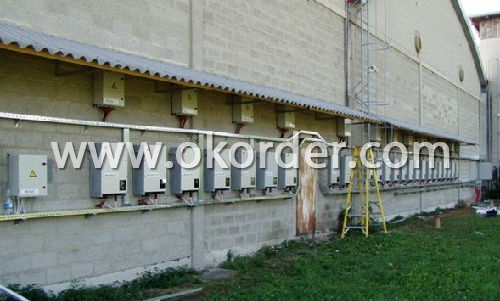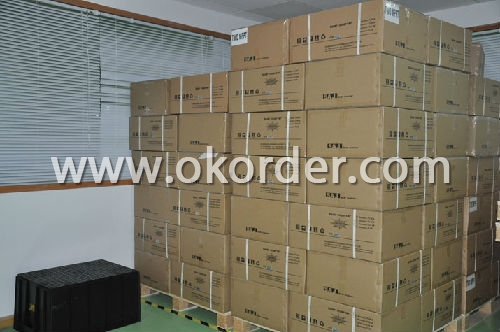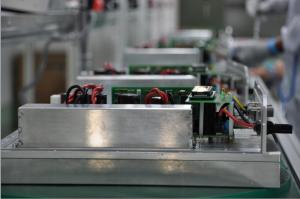Grid Tied Solar Inverter 3-Phase CNBM-12000UE
- Loading Port:
- NanJing
- Payment Terms:
- TT
- Min Order Qty:
- 1 set set
- Supply Capability:
- 1000 per month set/month
OKorder Service Pledge
OKorder Financial Service
You Might Also Like
Features of Grid Tied Solar Inverter 3-Phase CNBM-12000UE
With a R&D team more than 100 engineers,40% of the staff, who has been deeply engaged in the photovoltaic industry for 10 years, CNBM takes the mission to increase the inverter availability and efficiency, putting continuous innovation to make CNBM inverter easier for installation and operation, and more cost-effective for solar plant construction. The full range of CNBM single phase inverters has received VDE, CE, G83/1, G59/2, ENEL2010, VDE4105, C10/C11, AS4777 etc.
The Grid Connected Solar Inverter we can offer is 1.5kw to 20kw.
Introduction of Grid Tied Solar Inverter 3-Phase CNBM-12000UE
Maximum efficiency of 97.8% and wide input voltage range
Integrated DC switch-disconnected
MTL-String
Sound control
Bluetooth/RF technology /Wi-Fi
Transformerless GT topology
5 years warranty (10 years as optional)
Technical data of Grid Tied Solar Inverter 3-Phase CNBM-12000UE
Model | CNBM-10000UE | CNBM-12000UE | |
Input data (DC) |
|
| |
Max. DC power | 10500W | 12500W | |
Max. DC voltage | 1000V | 1000V | |
Start voltage | 350V | 350V | |
PV voltage range | 180V-1000V | 180V-1000V | |
Max. input current | 15A | 17A | |
Number of MPP trackers /strings per MPP tracker | 2/2 | 2/2 | |
Output (AC) |
| ||
Rated AC output power | 10000W | 12000W | |
Max. AC power | 10000VA | 12000VA | |
Max. output current | 16A | 19A | |
Power factor | 1 | 1 | |
THDI | <3% | <3% | |
AC connection | Three phase | Three phase | |
Efficiency |
| ||
Max. efficiency | 98% | 98% | |
Euro weighted efficiency | 97.5% | 97.5% | |
MPPT efficiency | 99.5% | 99.5% | |
Protection devices |
| ||
Output over voltage protection-varistor | yes | yes | |
Ground fault monitoring | yes | yes | |
Grid monitoring | yes | yes | |
General Data |
| ||
Dimensions (W / H / D) in mm | 740/440/235 | 740/440/235 | |
Weight | 41KG | 41KG | |
Operating temperature range | –25°C ... +60°C | –25°C ... +60°C | |
Altitude | 2000m(6560ft) without derating | ||
Self-Consumption night | < 0.5 W | < 0.5 W | |
Topology | Transformerless | ||
Cooling concept | Natural | Natural | |
Environmental Protection Rating | IP65 | IP65 | |
Features |
| ||
DC connection | H4/MC4(opt) | H4/MC4(opt) | |
Display | LCD | LCD | |
Interfaces: RS485/RS232/Bluetooth / RF/Zigbee/Wifi | yes/yes/opt/opt/opt | ||
Warranty: 5 years / 10 years | yes /opt | ||
Certificates and approvals | CE、VDE 0126-1-1、DK5940、G83/1-1、G59/2、RD1663、EN50438、 VDE-AR-N4105、CEI-021、IEC-62109、ENEL-Guide | ||
Grid Tied Solar Inverter 3-Phase CNBM-12000UE is simple national setting of line supply monitoring, Easy country configuration, with Multi-language,display, currently available for most of the countries over the world.With technical creativity and scientific management, the factory established first class R&D and test centers, as well as management and R&D teams comprising of PhDs and masters with overseas qualification.
Figure 1 the application of Grid Tied Solar Inverter 3-Phase CNBM-12000UE

Figure 2 The Stock of Grid Tied Solar Inverter 3-Phase CNBM-12000UE

- Q:Can a solar inverter be used with a hybrid solar power system?
- Yes, a solar inverter can be used with a hybrid solar power system. A hybrid solar power system typically consists of both solar panels and a secondary power source, such as batteries or a diesel generator. The solar inverter converts the direct current (DC) power generated by the solar panels into alternating current (AC) power that can be used to power appliances and devices in the home or business. Additionally, the solar inverter can also manage the flow of power between the solar panels, the batteries, and the grid, optimizing energy usage and ensuring a reliable power supply.
- Q:How do you monitor the performance of a solar inverter?
- To monitor the performance of a solar inverter, several methods can be employed. Firstly, real-time monitoring of key parameters such as voltage, current, and power output can be done using specialized monitoring devices or software. These tools provide a comprehensive overview of the inverter's performance, allowing for immediate identification of any issues or deviations from expected performance. Additionally, regular inspection and maintenance checks are crucial for performance monitoring. This involves visually inspecting the inverter for any physical damage or abnormalities, as well as checking the connections and wiring. Any signs of wear or malfunction should be promptly addressed to ensure optimal performance. Furthermore, data logging and analysis play a vital role in monitoring the inverter's performance over time. By collecting and analyzing historical data, trends and patterns can be identified, helping to detect potential issues or performance degradation. This can be done using software platforms that track and analyze the data from the inverter. Overall, a combination of real-time monitoring, regular inspections, and data analysis allows for effective performance monitoring of solar inverters, ensuring their optimal functioning and addressing any performance issues promptly.
- Q:Can a solar inverter be used with different types of grid connection standards?
- Yes, a solar inverter can be used with different types of grid connection standards as long as it is designed to meet the specific requirements of those standards. The inverter must be compatible with the voltage, frequency, and other technical specifications of the grid in order to ensure safe and efficient operation of the solar power system.
- Q:Can a solar inverter be used with solar-powered streetlights?
- Yes, a solar inverter can be used with solar-powered streetlights. The solar inverter is responsible for converting the direct current (DC) produced by the solar panels into alternating current (AC) that can be used to power streetlights. This conversion allows the solar-powered streetlights to operate efficiently and effectively, utilizing the energy generated by the solar panels.
- Q:Three-phase photovoltaic inverter grid, the use of phase-locked loop is what?
- Photovoltaic inverters for grid-connected photovoltaic power generation systems are primarily capable of receiving DC power from photovoltaic arrays and converting them into sine-wave currents of the same frequency and in phase with the access grid for powering the grid or local loads.
- Q:How does a solar inverter handle voltage regulation during sudden load changes?
- A solar inverter handles voltage regulation during sudden load changes by continuously monitoring the voltage and current outputs from the solar panels. When there is a sudden increase or decrease in the load, the inverter adjusts its power output accordingly to maintain a stable and consistent voltage level. This is achieved through a combination of control algorithms and power electronics within the inverter, ensuring that the voltage remains within an acceptable range to meet the demands of the load.
- Q:What is the operating temperature range of a solar inverter?
- The operating temperature range of a solar inverter typically varies, but it is commonly between -20°C to 60°C.
- Q:What is the role of transformerless design in a solar inverter?
- The role of transformerless design in a solar inverter is to eliminate the need for a bulky and expensive transformer, resulting in a more compact, lightweight, and cost-effective solution. Transformerless inverters use advanced electronic circuitry to convert the direct current (DC) generated by solar panels into alternating current (AC) that can be used to power household appliances or fed back into the grid. This design allows for higher efficiency, lower energy losses, and increased flexibility in system design and installation.
- Q:How does MPPT technology work in solar inverters?
- MPPT (Maximum Power Point Tracking) technology in solar inverters works by continuously adjusting the operating voltage and current of the solar panels to ensure the maximum power output. It does this by constantly monitoring the voltage and current of the solar panels and finding the optimal point (maximum power point) at which the panels can deliver the most power. This is achieved by varying the load on the panels to match their impedance with the maximum power point. MPPT technology maximizes the efficiency of solar power generation by extracting the maximum available power from the panels under varying environmental conditions such as shading, temperature changes, and panel degradation.
- Q:What are the key factors affecting the lifespan of a solar inverter?
- The key factors affecting the lifespan of a solar inverter include the quality of components used in its manufacturing, the design and construction of the inverter, the operating conditions and environment it is subjected to, and the maintenance and care it receives throughout its lifespan.
1. Manufacturer Overview |
|
|---|---|
| Location | Hefei,China |
| Year Established | 2004 |
| Annual Output Value | Above US$0.6 billion |
| Main Markets | Australia;Italy;Germany;U.K. England;Franch;NewZealand; |
| Company Certifications | Growatt5000;VDE0126;SAA;G83;TUV |
2. Manufacturer Certificates |
|
|---|---|
| a) Certification Name | |
| Range | |
| Reference | |
| Validity Period | |
3. Manufacturer Capability |
|
|---|---|
| a)Trade Capacity | |
| Nearest Port | Shenzhen |
| Export Percentage | 0.4 |
| No.of Employees in Trade Department | 10 People |
| Language Spoken: | English;Chinese;French;German |
| b)Factory Information | |
| Factory Size: | Above 15,000 square meters |
| No. of Production Lines | Above 5 |
| Contract Manufacturing | OEM Service Offered;Design Service Offered |
| Product Price Range | Average |
Send your message to us
Grid Tied Solar Inverter 3-Phase CNBM-12000UE
- Loading Port:
- NanJing
- Payment Terms:
- TT
- Min Order Qty:
- 1 set set
- Supply Capability:
- 1000 per month set/month
OKorder Service Pledge
OKorder Financial Service
Similar products
New products
Hot products
Hot Searches
Related keywords






























